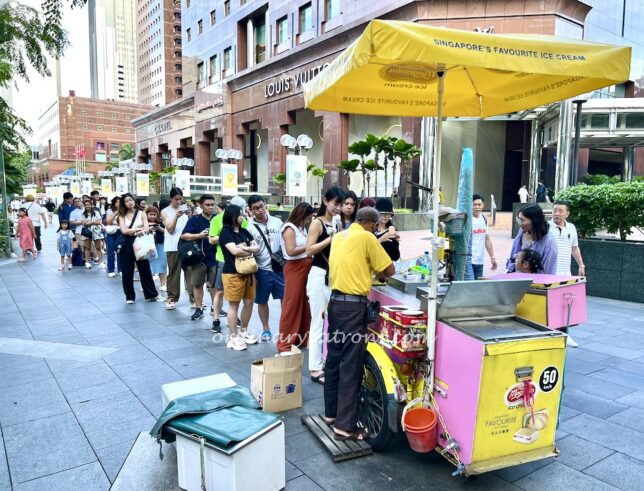2025 PSLE English Oral Exam Insights: Teachers’ Suggested Answers & Key Takeaways
- Walter Education

- Aug 16
- 4 min read
Updated: Aug 24

The PSLE English Oral exams are finally over, and students across Singapore can breathe a sigh of relief! This year’s themes—Day 1’s individual decision-making (like queuing for ice cream) and Day 2’s community-focused discussions (hawker centre culture)—gave students plenty to reflect on.
To help future candidates, we have compiled model responses, tips, and common observations from this year’s exam.
Whether you’re a parent preparing your child or a student curious about what examiners look for, this breakdown will guide you through:
Day 1’s focus on personal choices (Was the ice cream stall worth the wait?).
Day 2’s emphasis on shared experiences (Why hawker centres matter to Singapore’s identity).
How to structure balanced, thoughtful answers for any topic.
The oral exam isn’t just about fluency—it’s about connecting real-life situations to values like patience, community, and critical thinking. Here’s what we noticed this year…
Let’s dive in!
Day 1 - A Long Queue at a Busy Street for Ice Cream
(This is likely a picture-based conversation prompt where students discuss a scene of people queuing at a popular ice cream stall on a crowded street.)

Possible Picture Details:
A bustling street with pedestrians walking past.
A long line of people waiting at an ice cream cart.
Some people looking impatient, others chatting happily.
The stall vendor busy serving customers.
Why This Topic?
The PSLE Oral exam often uses real-life Singaporean scenarios to test:
Observation skills (describing the picture).
Personal opinions (e.g., queuing culture, food preferences).
Social values (e.g., patience, consideration for others).
Linked to Singaporean Context:
Hawker culture: Queuing is common for popular food stalls.
Civic-mindedness: Discussing if the stall location causes obstruction.
Convenience vs. Patience: Balancing efficiency with enjoyment (e.g., "Is the wait worth it?").
Q1: Do you think the ice cream stall is located at a good place?
Suggested Response:
Yes, I believe the ice cream stall is well-located because it is on a busy street with many passersby. An ice-cream stall set up on a busy street means more potential customers, which is good for business. However, the long queue might block pedestrian traffic, causing inconvenience. If the stall were slightly off the main walkway, it could reduce congestion while still attracting customers.
Q2: Would you queue for a long time for an item?
Suggested Response:
It depends on the situation. If it’s something I really like or a rare treat—such as my favourite flavour of ice cream—I might wait patiently. However, if the queue is too long, I would probably walk away. I prefer efficiency, so unless it’s very special, I will try to avoid long queues.
Q3: Do you think Singaporeans are organised?
Suggested Response:
Generally, yes. Singaporeans are known for being disciplined and orderly, especially in public spaces. For example, people queue neatly at hawker centres and MRT stations. However, in situations like the crowded ice cream stall, some might get impatient or cut queues. Overall, though, Singapore’s culture and systems encourage organisation and consideration for others.
Tips for Oral Exams:
Clarity & Fluency: Speak naturally, with complete sentences.
Personal Touch: Relate answers to your experiences (e.g., "Once, I queued for...").
Balance: For opinion questions, discuss both sides if possible.
Day 2 - based on the hawker centre scenario

image source reference: https://asianinspirations.com.au/food-knowledge/hawker-centres-the-street-food-havens-of-southeast-asia/
The Day 2 PSLE English Oral topic about a hawker centre is chosen because it reflects Singapore’s cultural identity, everyday life, and social values—key themes the Ministry of Education (MOE) emphasizes in oral exams.
Here’s why:
1. Hawker Centres Are Uniquely Singaporean
Cultural Heritage: Hawker centres are a UNESCO-listed intangible heritage, symbolizing Singapore’s multicultural food traditions (e.g., Chinese char kway teow, Malay nasi lemak, Indian roti prata).
Common Experience: Most students visit hawker centres regularly, making it relatable for discussions.
2. Tests Real-Life Communication Skills
Observation: Students describe scenes (e.g., crowded tables, diverse food stalls).
Opinion-Based: Questions like "Home vs. hawker food?" or "Should students cook?" assess critical thinking and personal voice.
3. Links to Social Values
Community Spirit: Hawker centres are shared spaces where people interact across races/ages.
Responsibility: Questions may touch on cleaning trays, patience in queues, or supporting local stalls.
Q1: Do you like to go to a hawker centre like this?
Suggested Response:
Yes, I enjoy visiting hawker centres because they offer a wide variety of affordable and delicious local food. The lively atmosphere makes dining there a fun experience. However, it can get crowded and noisy during peak hours, which might be uncomfortable for some people. Overall, I like hawker centres because they reflect Singapore’s vibrant food culture.
Q2: Do you like to eat at home or at a hawker centre?
Suggested Response:
It depends. Eating at home is more comfortable because my family prepares healthier meals, and we can bond over dinner. However, I also enjoy hawker centres for their convenience and variety—especially when my parents are busy. If I had to choose, I’d prefer home-cooked meals for weekdays and hawker food as an occasional treat.
Q3: Do you think students should learn cooking?
Suggested Response:
Absolutely! Learning to cook is an essential life skill. It helps students become independent, eat healthier, and even save money. Simple dishes like fried rice or pasta are easy to start with. Schools or parents can teach basic cooking, which also encourages creativity and responsibility. Plus, it’s a useful skill for adulthood.
Bonus Tips for Stronger Responses:
Add Examples:
"Once, I tried cooking noodles myself and realised how fun it was!"
"My favourite hawker dish is chicken rice because…"
Show Maturity:
For Q3, mention "Even if they make mistakes, students learn perseverance."
Speak Naturally: Use phrases like "In my opinion…" or "From my experience…" to sound conversational.





